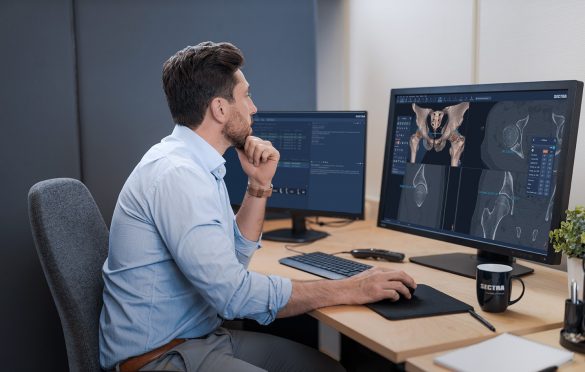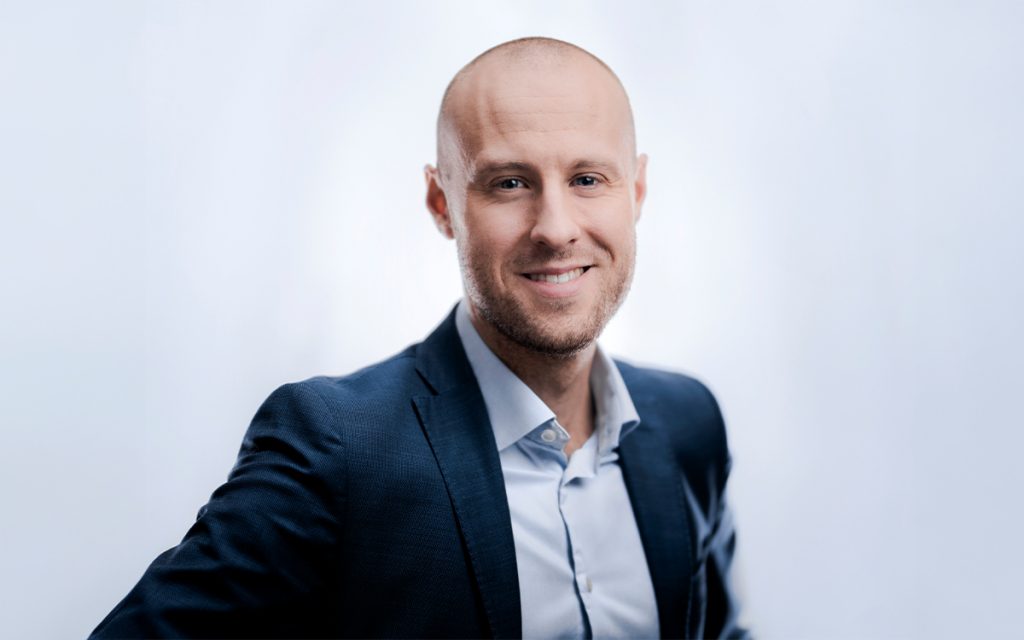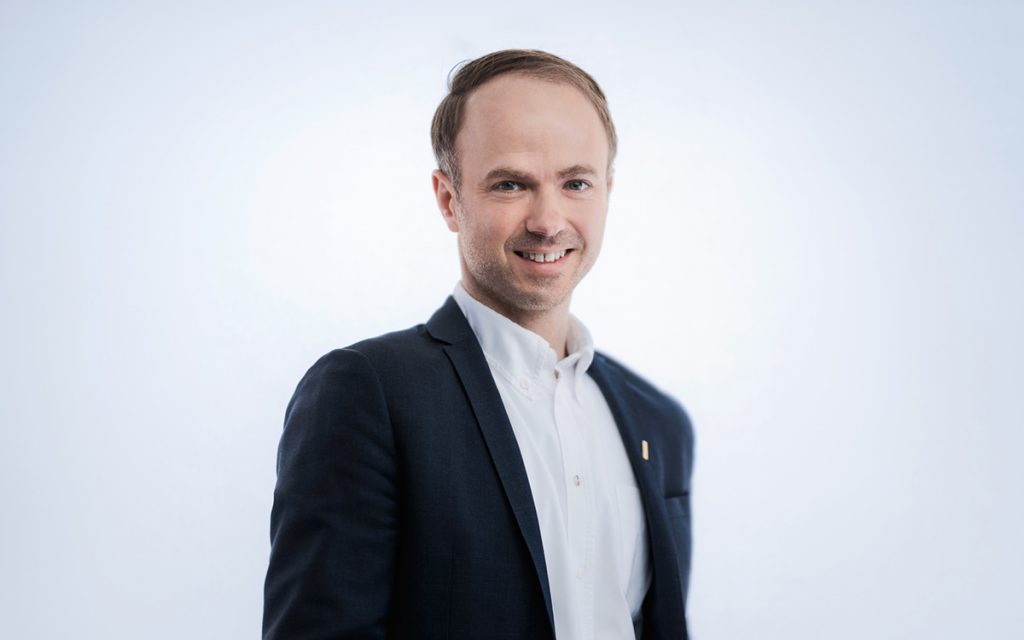Business Innovation includes the Orthopaedics, Genomics IT and Medical Education business units as well as Sectra’s research department. Business Innovation also manages and develops Sectra’s patent portfolio.
Quick facts
- 48 employees
- SEK 91 million in revenue
Figures refers to fiscal year 2024/2025.
The Group incubator
Business Innovation is the Group’s primary incubator. This includes business units, research operations and future projects that, in their current phases, can benefit from being pursued in an incubator environment or that do not easily fit into any of our existing operating areas. The latter may be because the products and services are intended for a customer segment that we are not currently targeting. In Business Innovation, there are currently only medical technology projects and operations, but this may be expanded to include projects in other areas in the future.
The long-term ambitions for Business Innovation are to:
- contribute to better care for patients by solving difficult and important problems encountered by Sectra’s customers,
- commercialize new technology, validate clinical benefits or pursue projects that could lead to new and innovative solutions that add value for customers in Sectra’s niche areas,
- give smaller operations and business units the best conditions to develop and grow,
- build and manage a strong patent portfolio in Sectra’s key areas and
- develop business models for new products and services.
The research department’s roles are to support Sectra’s established areas and to evaluate and conduct long-term, high-risk projects that can result in business within three to ten years.
Some projects soar while others fade away
Sound scientific and medical evidence is essential in healthcare. Implementing new technologies and methods is often a protracted process and associated with high risk. As a result, some research and other early-phase projects will never grow to any major degree.
In some cases, the operations in Business Innovation are already profitable with existing customers, but they need to grow further. In the long term, the business units and projects are to be managed in one of the following ways:
- become a separate operating area
- incorporate the unit into an existing operating area. This occurred, for example, when digital pathology was transferred to Imaging IT Solutions in 2014, due to the major synergies identified
- discontinue if the unit does not offer sufficient potential. This occurred, for example, with the osteoporosis business unit in 2017/2018
- spin off as an independent company or be sold to an external party if this proves to be the best solution from a financial standpoint. This occurred, for example, with the business unit for low-dose mammography products, which was divested in 2011 and when patents were sold in 2015.
Business units
Safer surgery using digital planning
Joint replacement surgery is by far the largest market segment within orthopaedics and is responsible for more than one-third of total revenue in the orthopaedics market. The segment is expected to grow significantly due to the aging population. In addition, several million surgeries are performed globally every year due to fractures caused by accidents, falls and activity-related injuries. To meet the growing need for better, more efficient care related to these kinds of surgical procedures, Sectra offers IT systems for image based planning and follow-up of orthopaedic surgery.
For healthcare providers, increased precision in diagnosis, planning and monitoring leads to reduced costs, since the operating time is shortened while the number of implants to be prepared before every surgery is reduced. For the patient, shorter operating times reduce the risk of postoperative infections and other complications. An accurate diagnosis before surgery also reduces the risk of unnecessary and risky surgery, such as revision surgery in the case of a suspected loose implant.
Sectra’s orthopaedics offering also includes tools that improve and simplify work for radiologists who specialize in the musculoskeletal system (musculoskeletal radiology). These tools allow radiologists to perform otherwise difficult and time-consuming measurements more quickly and efficiently. In addition, the ability for orthopaedic surgeons and radiologists to work together in the same system also saves additional time, with faster diagnoses as a result.
Furthermore, our solutions also contribute to simplifying and streamlining the proof-of-concept process for new implants. Sectra’s service now makes it possible to use computer tomography to measure movement between the implant and bone in an entirely new way. Scientists and implant manufacturers are thus able to increase the quality and long-term survival rates of new implants, which is of the utmost importance for patient safety.
The way forward
The business unit’s ambition is to contribute to improved orthopaedic preoperative planning and postoperative follow-up through the development and sale of services and software for image-based orthopaedic planning and follow-up. This is how we can help our customers provide better, more cost-efficient care to patients.
Prioritized activities:
- primarily growing in those parts of Europe and North America where the business unit has an in-house sales organization and where Sectra already has an established customer base,
- sales to larger customers with a significant orthopaedic department, who thus have a need for our entire product portfolio,
- ongoing development of our musculoskeletal radiology offering and
- gathering evidence and disseminating knowledge of our products and services via clinical studies.
Customers and sales channels
The business unit’s customers are private and public orthopaedic clinics as well as manufacturers of prosthetics and implants. Sales take place through an in-house sales organization, distribution partners and as part of Sectra Imaging IT Solutions’ customer offerings.
Market position
Sectra is currently the market leader in preoperative planning of orthopaedic procedures in Scandinavia. We also command a strong market position in several other countries, including the Netherlands and the UK, and have a growing customer base in the US.

Cloud-based training platforms for reality-based learning
The need for care is continuously increasing alongside a growing labor shortage. Managing these challenges requires innovative ways of working, digital tools and increased investments in the types of services that Sectra offers in medical education. Sectra Education Portal is a cloud-based service that offers reality-based learning using anonymized patient cases and advanced digital diagnostic imaging tools
The education portal is used for connecting theoretical knowledge to real clinical scenarios and diagnostic tools. This supports learning, all the way from basic levels for students to advanced professional development for specialists and other qualified healthcare personnel. The cloud service is available at any time or location, giving the user full control over their own learning. This applies regardless of whether the user is at the hospital, the university or at home. In addition to Sectra Education Portal, Sectra’s visualization table is also available for use in classrooms or lecture halls.
The way forward
Our ambition is to help our customers to improve and streamline medical education by facilitating lifelong learning and continuous professional development for healthcare personnel.
Prioritized activities:
- continuing to expand existing customers’ usage in order to help them maximize the value of the portal,
- increasing sales and the number of subscribers, focusing primarily on Europe and North America. In part by strengthening synergies within the Imaging IT Solutions operating area’s existing customer base and
- further refining the customer offering to meet the needs in basic medical education and specialist training in the hospital segment.
Customers and sales channels
The business unit’s customers are educational institutions and hospitals offering basic and specialist medical or veterinary studies, both privately and publicly. Sales mainly take place through an international network of distribution partners. In certain markets, such as Sweden, offerings are also provided as part of Sectra Imaging IT Solutions’ customer solutions.
Market position
Sectra’s cloud-based education portal, with advanced visualization tools for medical diagnostics and a broad library of anonymized patient cases, offers a unique solution for medical learning at all levels. Our customers can be found in more than 50 countries, and include many of the world’s leading educational institutions and hospitals.

Driving innovation in personalized medicine
Each patient is unique, and customizing healthcare to each individual patient’s need is essential for the patient outcomes. Personalized medicine, also referred to as precision medicine, is the emerging practice of medicine that uses an individual’s genetic profile to guide decisions made in regard to the prevention, diagnosis, and treatment of disease. This practice is especially well developed within cancer care. By leveraging all patient data, from radiology, pathology and finally genomics, the most advantageous cancer treatment path is chosen for each individual patient.
Due to its essential role in treatment, genomics is one of the fastest growing fields within diagnostics. To efficiently provide precision diagnostics, close collaboration between multiple medical specialties is needed to support these new diagnostic workflows. In collaboration with healthcare providers in the US and Sweden, Sectra is driving innovative product development in this field to further increase the value provided to customers. The situation is similar to when the digital pathology product was launched as an expansion of Sectra’s radiology offering. By combining medical imaging IT for radiology and pathology with IT support for genomics, we are helping to develop the diagnostics of the future.
Sectra’s offering in this area is being developed within the Genomics IT business unit, which was started in 2022. The ongoing development project spans several years and is off to a good start. Together with one of the most prominent cancer healthcare providers in the US, we put the first version of the system into clinical operation in spring 2024.
The way forward
The ambition is to facilitate cancer diagnostics so that more patients can receive personalized medicine. We achieve this by developing and selling services for managing large volumes of genomic data analyses and contributing to better integrated diagnostics. The services are part of Sectra’s unique solution for integrated diagnostics, where medical images and information from pathology and radiology can be combined with molecular diagnostics in the form of genomics.
After an initial successful introduction of IT support for genomics, the focus is now on controlled growth in North America and Europe. This will involve a rigorous process to ensure successful implementation with new customers and further development of our customer offering.
Prioritized activities:
- identifying and verifying new customers,
- directed marketing initiatives to increase visibility in the rapidly growing genomics market,
- further developing the customer offering to meet sequencing diagnostics needs and
- further developing integrations between genomics and fields such as pathology and radiology.

Innovation for sustainable growth
The research department conducts and participates in projects to provide scientific support for existing technology as well as to create new products—all in an effort to boost the company’s long-term business value. Three of the employees divide their positions between Sectra and Linköping University, where the research is primarily performed in cooperation with the Center for Medical Image Science and Visualization (CMIV). Sectra is currently involved in approximately ten research projects, including projects in the fields of digital pathology and genomics. Previous projects have resulted in improvements and expansions to our product offering.
Progress in data-intensive diagnostics
An overarching theme for the initiatives in the research department is data-intensive diagnostics that support healthcare’s development towards precision medicine. One area Sectra is studying is the decision support that will be needed for the healthcare sector’s diagnostic analyses in genomics, known as variant analysis. Another project is looking at combing data from multiple sources, for example from pathology and genomics, in AI analyses. We are also participating in research into how the latest AI language models can be used in innovative tools, for example for radiologists.
Facilitating AI use in healthcare
Sectra also contributes research in diagnostic imaging so that AI can move from the laboratory to clinical reality. Sectra is one of the main participants in the Vinnova-funded project AIDA, which serves as a national arena for research into AI for medical image analysis, with the aim of leveraging the full benefits of AI-based tools in the healthcare sector.
Several initiatives aim to support the development of innovations based on healthcare data, not least through AI. Sectra provides tools for advanced and responsible data sharing to the Innovative Medicines Initiative program under the EU Bigpicture project as well as the Swedish ValCuria project. Sectra’s contribution will accelerate the development of improved diagnostic methods based on AI and support collaborative efforts between healthcare and research.
Management

Gustaf Schwang
General Manager Orthopaedics business unit

Johan Carlegrim
General Manager Medical Education business unit

Fredrik Lysholm
General Manager Genomics IT business unit

Claes Lundström
Research Director Medical Systems

